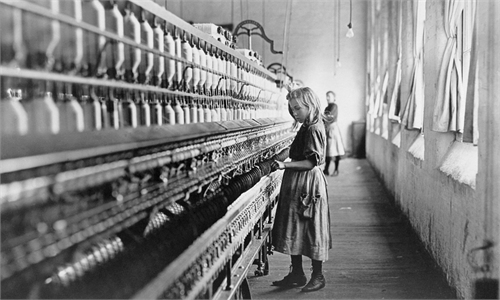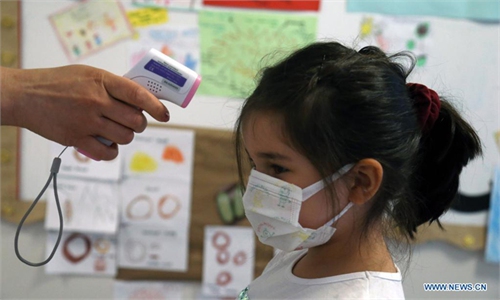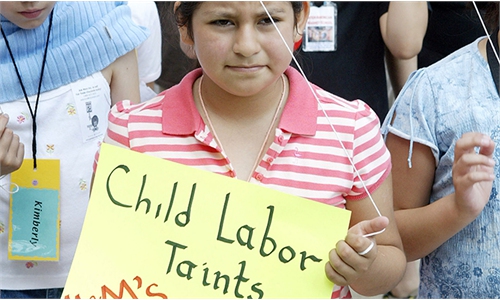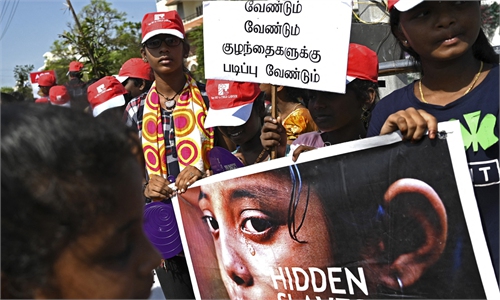GT investigates: Cheaper than machines, working 70 hours under exploitive laws – life of 500,000 US child farmworkers
Production line childhood
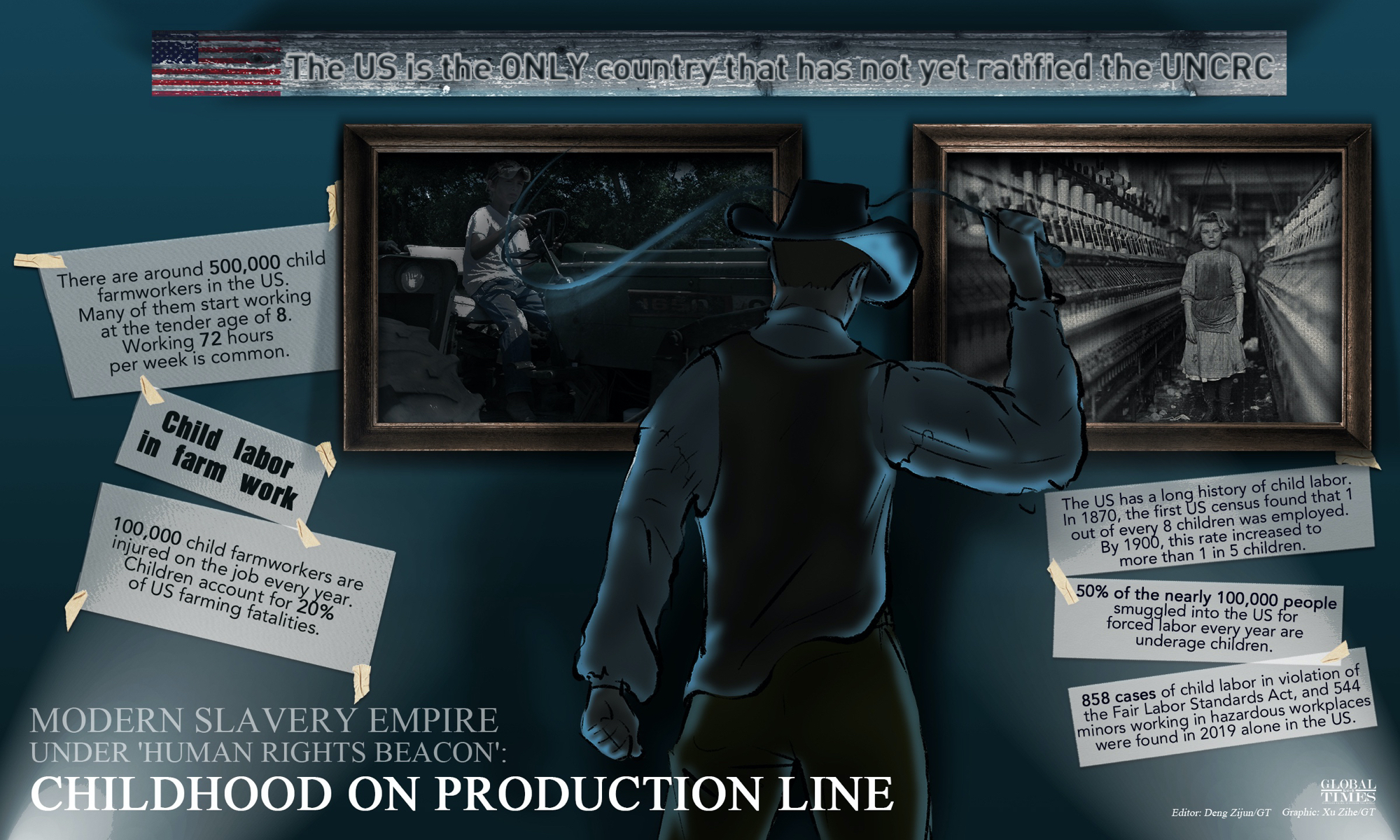
Graphic: Xu Zihe/GT
Editor's Note:Inmates in prisons are subject to labor exploitation, minors working as child laborers are abused, human trafficking remains rampant: Today, more than 150 years after the abolition of slavery in the US, the above-mentioned problems still exist in the country. Some American politicians have racked their brains to fabricate the "sad narrative" of "forced labor" in China's Xinjiang region, but a lie repeated a thousand times is still a lie. It is the US, a self-claimed "human rights defender" and "beacon of freedom," that should be held accountable for using forced labor, as the tragedies happening on US soil plainly demonstrate the US' disregard for basic human rights and their brutal exploitation of the country's workforce.
The Global Times is publishing a series of stories that will uncover the four crimes of the US, a real "modern slavery empire." The following is the second installment of the series.
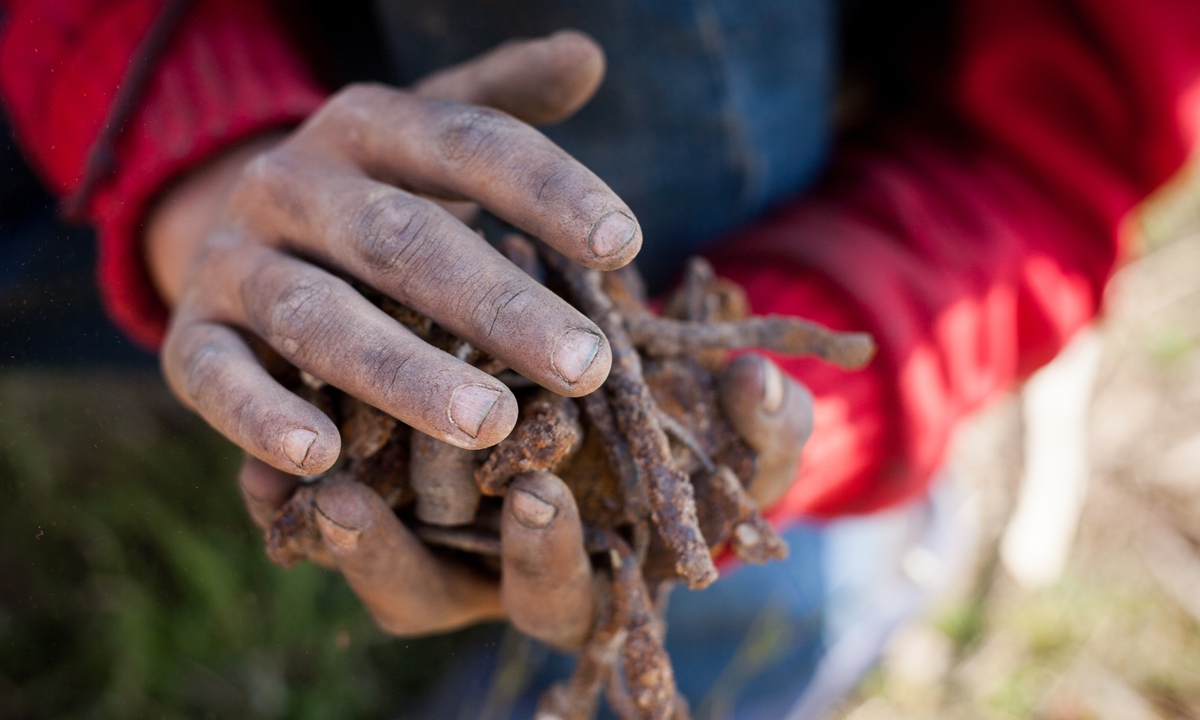
Photo: VCG
Long working hours, malnutrition, beatings. Most people may remember the horrors described in Oliver Twist, Charles Dickens' classic novel, which exposed the abuse of children in factories and farms in 19th century London. In today's world where most children live in safety, receive education and enjoy a carefree childhood, many assume that the atrocities of child labor had long been expunged from the planet. Few would expect there are still half a million children working on US farmlands.
Notably, it is not just a problem in "poor countries." A report from the World Vision International in 2021 shows that about 93 million child laborers, or 58 percent of those in child labor, live in middle-income countries, and 1.6 million child laborers live in high-income countries.
Among these high-income countries, the US, a country promoting itself as a beacon of human rights, has been criticized not only by the International Labor Organization but also by domestic child rights protection groups for standing alone in its unwillingness to ratify the United Nations Convention on the Rights of the Child.
Many Americans might have never heard of the Convention and also might not know that their food may have been picked by one of the approximately 500,000 child farmworkers in today's US.
And the startling statistic continues.
In the past five years, as many as 100,000 people have been trafficked into the US and exploited as forced labor, with half of them being literally sold to "sweatshops" or domestic servitude. Among the exploited there are half a million child laborers, many under the age of 10 and working up to 72 hours a week. About 240,000 to 325,000 women and children in the US are sexually enslaved, and children survive an average of just seven years after being trafficked.
Chinese experts noted that behind these statistics are veritable human tragedies, broken families, and real people whose basic rights have been violated. The so-called beacon of human rights does not shine light on its dark history, and its human rights toolkit has never been aimed at its own social plights.
The US needs to face up to its own serious child labor issues and respond to the international community's concerns sooner rather than later. Otherwise, the country will only exacerbate the human rights tragedy of child labor around the world.
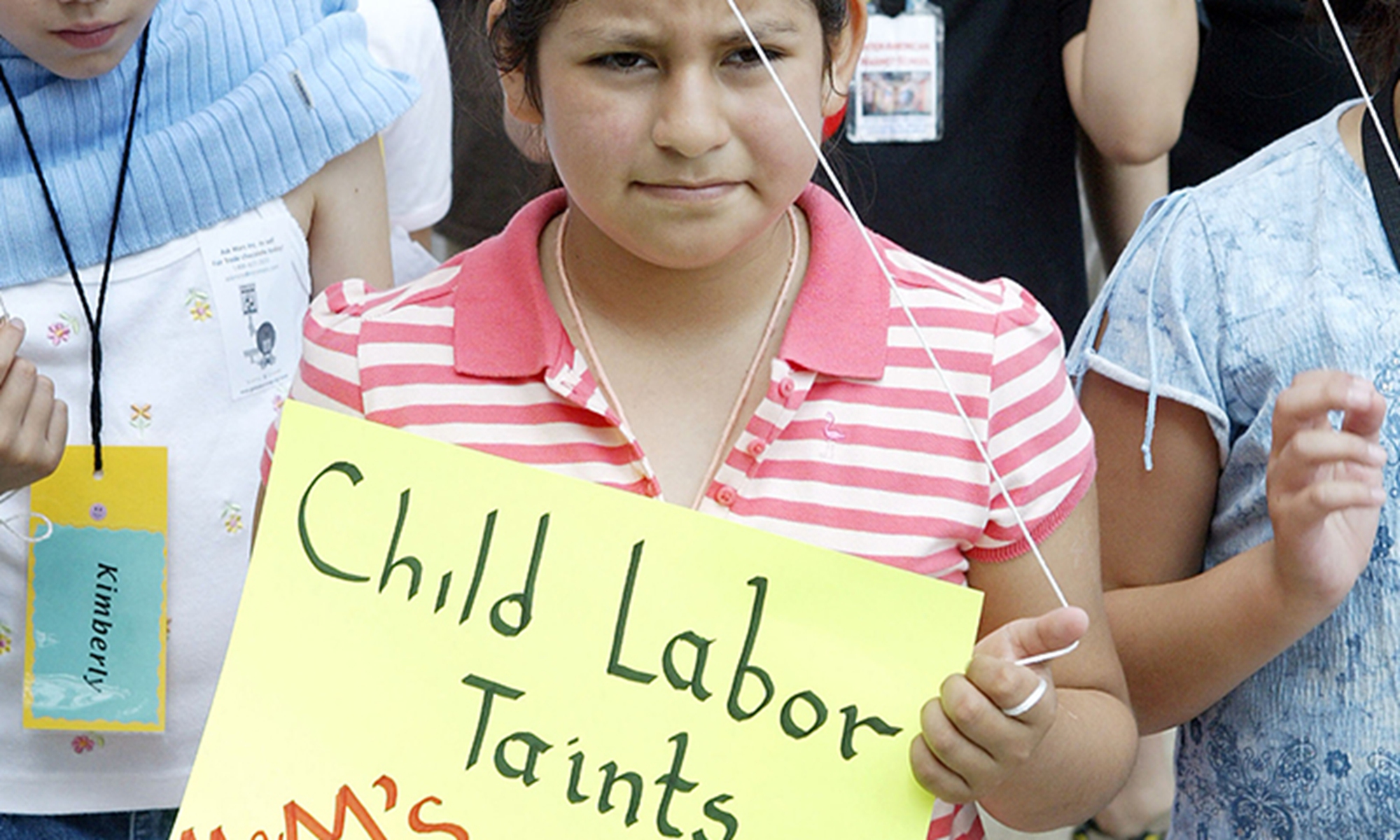
Children protest to demand M&M Mars candy company stop sourcing cocoa from suppliers using child labor in Chicago in 2004. Photo: AFP
Modern-day Oliver Twist
Every year on weekends and summer vacations, thousands of children get up at the break of the dawn in buses. Their destinations are not a summer camp or school, but a place of work. They arrive at the farm at 6 am, and leave at 8 pm, working 10-12 hours a day. They are child laborers at US tobacco farms.
Like the slave trade and racial discrimination issues, child labor in the US dates back to more than a century ago, when child laborers were hired and exploited to work down mine shafts, on tobacco farms and in textile factories. The issue remains unresolved today.
Child labor was abolished in the US in 1938, when Congress enacted the Fair Labor Standards Act, which restricted most child labor below age 16 and limited hazardous work to individuals over 18. However, these regulations do not apply to agricultural labor because of outdated exemptions based upon an agrarian society largely left to the past.
As a result, the horrors of child labor are still a reality in some agricultural contexts. Showing no difference with impoverished countries around the world, children in the US are permitted, even compelled, to do hazardous, back-breaking work to support themselves and their families. This work exposes them to chemicals that will impact their health throughout their lifetime and an environment that will limit their opportunities, creating a vicious cycle of poverty and exploitation.
Estimates based on figures gathered by the US Department of Labor and published by the Association of Farmwoker Opportunity Programs (AFOP), an advocate for rights of migrant and seasonal farmworkers in the US since 1971, suggest that there are approximately 500,000 child farmworkers present in the US.
Many of these children start working as young as 8, and go through grueling 72-hour work weeks (more than 10 hours per day), the association said.
In October 2021, faced with a labor shortage, the US Wisconsin Senate proposed a bill to lengthen the allowed workday for teens under age 16, which reads like a sequel to Oliver Twist.
Senate Bill 332 would allow employees aged 14 or 15 to work until 9:30 pm before a school day and until 11 pm when they don't have school the next day, according to media reports.
Farms are the most dangerous places to work in the US for children. A report by the federal Government Accountability Office released in November 2018 presented alarming findings. Researchers found that between 2003 and 2016, 237 children died while working on farms in the US. This happens despite the fact that farms employ less than 6 percent of child workers, highlighting the devastating consequences of weak laws and regulations that don't properly protect child farmworkers.
The AFOP also pointed out agriculture is the US' most dangerous occupation for farmworker youth, while pesticides increase the risk of developmental disorders in farmworker children.
"Children are at greater health risk from pesticide exposure than adults. Pesticides have been linked to numerous health problems, including asthma, dermatitis, learning disabilities, leukemia, brain tumors and certain childhood cancers. Several factors contribute to this vulnerability. We may think of children as 'little adults,' but in fact, their bodies are not fully prepared to handle toxic chemicals," according to the AFOP.
Zhu Ying, a professor of human rights law at Southwest University of Political Science and Law, pointed out that among the industries, of particular concern is the prevalence of child labor in the tobacco industry.
"Tobacco is a labor-intensive industry, which requires numerous workforces. As the cost of using modern machinery in the tobacco industry is much higher than manpower, in order to reduce costs, the use of child labor has become a tradition," Zhu said.
In addition, the tobacco industry is a gray zone in many cities where local companies would find workers through illegal immigration, which has led to rampant child labor, Zhu said.
On its platform the AFOP offers an annual Art and Essay Contest to showcase farmworker children's heartwarming and compelling stories. The Global Times reporters were touched by the images and words that had been submitted by the children - words of hope and struggle coming from the US' most marginalized population.
"I believe people think food comes from a machine or something. They don't really know that the food really comes from us," read a message left by 16-year-old farmworker Edgar.
"Being part of a farmworker family is somehow learning to hustle but never realizing it because your struggle is actually your normal, a normal that is not normal for everyone else," writes Emily WA.
In a special survey with farmworker children from three different regions in the West, East and Mid-Central US, the AFOP found that 75 percent of these children are under 15 years old, 49 percent are female while 51 are male. About 95 percent of the kids surveyed started working in the fields between ages 5 and 6, and 78 percent of them said that they liked going to school more than going to work in the fields.
These are the stories of farmworker children shared by the AFOP, stories like that of Joel, who works long days in the hot sun, suffering from a headache and impatient to go home. Of Iker, a 7-year-old who has worked since he was 5 and just wishes the bathroom was closer. Of 16-year-old Jharexy, who harvests onions to help her parents buy gas and pay the bills. Far from the rosy ideal of kids learning skills and gaining a good work ethic, Joel, Iker, Jharexy and many others are working themselves to the bone just to keep their families out of poverty, putting their own short- and long-term health at risk in the process.
But child labor in the US is all but invisible, and very few people are rushing to correct that misconception. This is because it's in many people's interests to keep child labor hidden. It's in the employers' interest, because it keeps farmworker wages depressed, it's in the consumers' interest, because it keeps grocery costs down and it's in the parents' interest, because "many hands make light work." When children labor in the shadows, they carry these burdens of low wages, low costs, and higher pay on their own shoulders, the AFOP said.
He Zhipeng, a professor of international law at the School of Law with Jilin University, told the Global Times that many laws and practices in the US deviate from the provisions of the Convention on the Rights of the Child, which makes the US government fear it may face more pressure and condemnation by the international community to change its domestic laws if it joins the Convention.
"The US didn't join the Convention because the country arrogantly believes that its standards of child rights guarantees were higher than the Convention. But deep down, the root cause is the 'stubborn disease' of the country's class division, ethnic division and occupational division," Zhu said.
There are many defects and problems in human rights in the US. In addition to advocating for empty freedom complacently, the development and progress of national governance in the field of human rights is really lacking in the US, He said.
The expert noted that labor shortage is not a reasonshould not be an exuse to violate the basic moral and value consensus of human society. If it is okay to hire child laborers because of labor shortage, is it okay to kidnap slaves abroad and return to slavery? He asked.
Danny Haiphong, an independent journalist in the US, and co-editor of Friends of Socialist China, believed that the US rejects the Convention for the same reason it rejects nearly every international convention and treaty: hegemonism.
"The US does not believe in being regulated or guided by a framework outside of itself. In this particular case, rejecting the Convention also serves the bottom-line of powerful agribusiness corporations which exploit child labor to accumulate extra profits. By rejecting accountability, monopolies can feel comforted that domestic politics will serve them and provide loopholes for the child labor problem to continue," Haiphong told the Global Times.
That the US would attempt to punish China over forced labor is a clear act of imperial projection, Haiphong said.
Ahead of June 12 which marks the World Day Against Child Labor, Chinese Foreign Ministry Spokesperson Zhao Lijian stressed that the miseries of US child laborers are only the tip of the iceberg of the US's systemic human rights violations. The US needs to face squarely and address earnestly the infringement on child laborers' rights at home, ratify the United Nations Convention on the Rights of the Child as soon as possible, and properly protect American children's lawful rights and interests.


